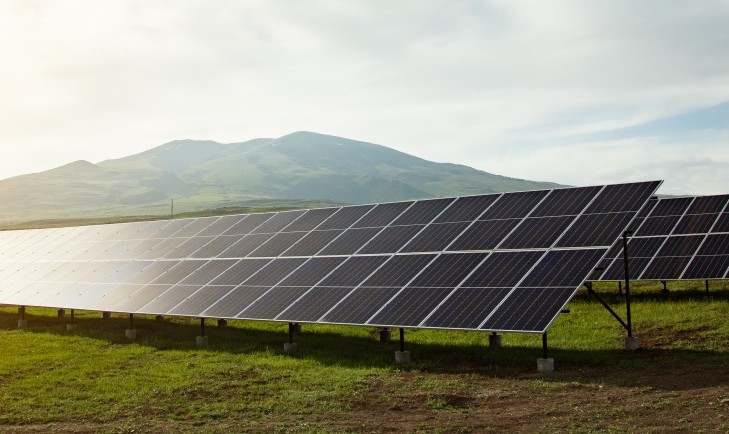
The Western Governors' Association keeps you updated on the latest news in the West. Here are the top stories for the week starting April 29th, 2024. (Photos courtesy of Adobe Stock Images and Dennis Schroeder, NREL)
2023 saw a boom in solar development across the West, with Texas, California, and Colorado sitting among the top five states in the country for solar installations last year.
With new solar being added to the grid, projects are ongoing in several western states to improve battery storage capacity for renewable energy. The Nova Power Bank, which is currently under construction in Menifee, CA, will provide improved energy storage when it comes online in 2025. The 680-megawatt power bank is being built on the site of a former natural gas plant and it will be one of the world’s largest facilities of its kind once completed.
In Utah, the Green River Energy Center is quadrupling its lithium battery storage capacity, allowing the solar plant to store up to 1,600 megawatt hours of electricity.
Colorado ranked 4th in the country for the most solar installed in 2023, with 1.6 GW installed last year. That figure is nearly 10 times the amount installed the year before. Colorado’s spike in solar is thanks in part to a bill signed by Governor Jared Polis that committed the state to a net-zero greenhouse gas emissions target and opened the door for the rapid development of a clean energy future in the state. 
Large solar arrays are also coming online in Wyoming and South Dakota, adding to the vast and growing network of solar in the West.
Leading the country in solar installations in 2023 was Texas, where the Lone Star State added 6.5 GW of solar last year. Just in the past few years, Texas has put up 15 GW of new solar, which is more than the entire country installed in 2019.
Drones protecting livestock: with wolves being reintroduced to states like Colorado, ranchers and researchers have been getting creative with techniques to keep predators away from livestock in safe and humane ways. Recently, researchers with the USDA Wildlife Services in Oregon have been experimenting with drones outfitted with speakers that can broadcast human voices to deter wolves before they make an attack.
In Montana, rancher Daniel Anderson has been using drones to keep tabs on his livestock since 2017. He uses his drone to check on his herd from afar, which allows him to keep an eye out without having to risk a run-in with a grizzly or a wolf.
USDA researchers hope that drones can help protect both livestock and predators by keeping the two apart with nonlethal and minimally invasive strategies.
Protecting water from wildfire: a new grant program in Colorado is doling out $10 million in federal funds to help communities identify areas that could be most affected by the aftereffects of wildfires, such as floods, erosion, and debris flows. After the scorching heat of a wildfire, burned areas lose much of the vegetation that holds soil in place, and fires can destroy an area’s ability to absorb moisture, making burn scars much more prone to erosion.
The program aims to prevent natural disasters like the massive debris flow that buried Interstate 70 in Glenwood Canyon back in 2021. That slide started in a wildfire scar and tore past the Interstate, clogging the Colorado River and downstream watersheds.
The new program from the Colorado Water Conservation Board will support projects that help manage ecosystems, restore forests, and understand the changes to drainage and runoff patterns after wildfires. “Anything you can do for planning makes a big difference in the long run when it (a natural disaster) actually does happen at your doorstep,” said Paula Stepp, who was on the Glenwood Springs City Council during the 2021 debris flow. So far, the Water Conservation Board has awarded $5.2 of its allotted $10 million, with the rest to be given out before the end of the year.
Check out WGA’s Out West podcast on post-fire restoration to learn more about the challenges and available resources for wildfire-affected communities.
Doomsday plane: The Air Force recently announced that it has awarded a $13 billion contract to Sierra Nevada Corp. to build a "doomsday plane" that would be able to fly during a nuclear conflict.
The new “Survivable Airborne Operations Center” will replace the aging E-4B Nightwatch planes, which have been operational since the 1970s. The ‘doomsday plane’ is designed to allow the President and other top officials to operate in the event of a nuclear war or other catastrophic disaster that destroys command centers on the ground. Construction will take place in several locations, including Sparks, Nevada, and Englewood, Colorado, with the project expected to be completed in 2036.
Easier solar panel recycling: new research from U.S. Department of Energy’s National Renewable Energy Laboratory (NREL) shows promising new developments that would allow for solar panels to be more easily recycled. Currently, solar panels are welded together using troublesome plastic polymer sheets that make the process of recycling much more difficult. NREL’s research shows that a highly focused femtosecond laser could be used to weld solar panels together directly, cutting out the need for difficult-to-recycle polymer sheets. The glass-to-glass welds proposed by NREL would allow the glass and metal wiring inside solar panels to be cleanly recycled, and the panel’s silicon could be reused.